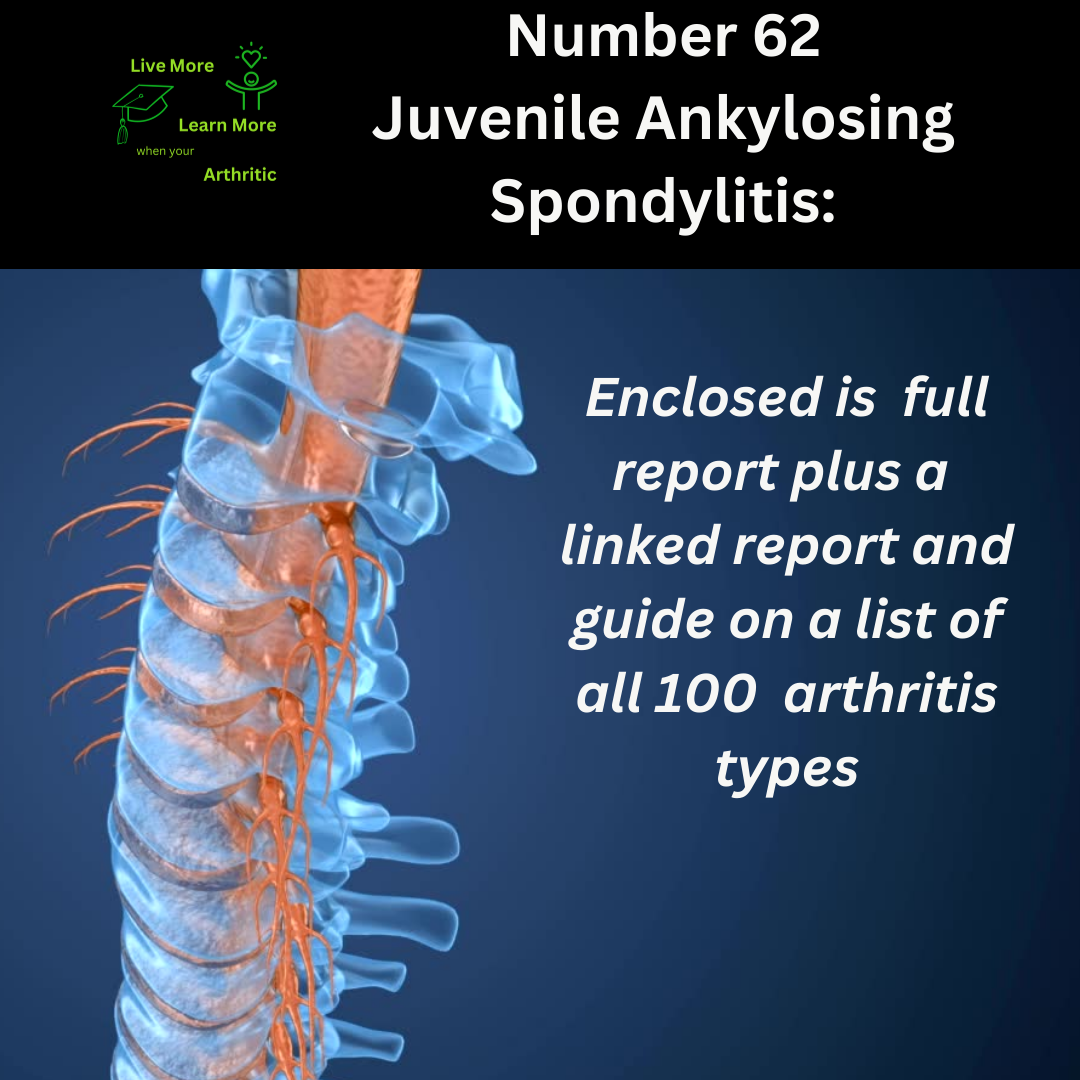
Juvenile Ankylosing Spondylitis: Number 62 on the list of 100 types of Arthritis
Juvenile ankylosing spondylitis (JAS), also known as juvenile-onset ankylosing spondylitis, is a form of arthritis that primarily affects children and adolescents. While this condition shares similarities with adult-onset ankylosing spondylitis (AS), it has distinct characteristics and challenges due to its early onset.
Three other articles on Ankylosing Spondylitis:
Juvenile Ankylosing Spondylitis: Number 62 on the list of 100 types of Arthritis
Ankylosing Spondylitis Number 4 on the list of 100 types of Arthritis
Description of Juvenile Ankylosing Spondylitis
Juvenile ankylosing spondylitis is a chronic inflammatory arthritis primarily affecting the spine and sacroiliac joints (the joints that connect the lower spine and pelvis). Over time, inflammation can lead to fusion of these joints, causing stiffness and limited mobility. Unlike some other forms of arthritis, JAS can also affect other joints, such as the hips, knees, and shoulders.
Causes and Triggers
The exact cause of juvenile ankylosing spondylitis is not fully understood, but it is believed to be related to genetic factors. Certain genetic markers, particularly the HLA-B27 gene, are strongly associated with the development of AS, including in children. Environmental factors may also play a role in triggering the onset of symptoms in genetically predisposed individuals.
Symptoms
The hallmark symptoms of juvenile ankylosing spondylitis include:
- Chronic back pain: Persistent pain and stiffness in the lower back, which often worsens with rest and improves with movement.
- Limited range of motion: Difficulty bending or turning the spine due to inflammation and eventual joint fusion.
- Fatigue: Feeling tired or lacking energy, which can be a result of chronic inflammation.
- Joint pain and swelling: Inflammation can affect other joints, leading to pain, swelling, and warmth.
Common Ages of Onset
Juvenile ankylosing spondylitis typically begins between the ages of 8 and 16 years, although it can sometimes appear earlier or later. The early onset of symptoms can significantly impact a child’s physical development and quality of life.
Impact on Lifespan
Juvenile ankylosing spondylitis does not typically shorten one’s lifespan. However, it can lead to significant disability if not managed effectively, affecting mobility and overall well-being.
Juvenile ankylosing spondylitis is considered an autoimmune disease. The immune system mistakenly attacks healthy tissues, particularly in the joints, leading to inflammation and joint damage.
Achieving a Higher Quality of Life
While there is no cure for juvenile ankylosing spondylitis, a proactive approach to management can significantly improve quality of life. This includes:
- Physical therapy: Regular exercise and stretching can help maintain joint flexibility and reduce stiffness.
- Medication: Although you requested no medication discussion, it’s important to note that certain medications, such as nonsteroidal anti-inflammatory drugs (NSAIDs) and biologic agents, can help control inflammation and slow disease progression.
- Healthy lifestyle: Eating a balanced diet, maintaining a healthy weight, and avoiding smoking can also support overall health and well-being.
Possible Complications
Complications of juvenile ankylosing spondylitis can include:
- Spinal fusion: Over time, inflammation and joint damage can lead to the fusion of vertebrae in the spine, resulting in loss of flexibility and increased pain.
- Eye inflammation: Some individuals with AS may develop inflammation in the eyes (uveitis), which requires prompt treatment to prevent complications.
- Cardiovascular issues: Chronic inflammation can increase the risk of cardiovascular problems, such as heart disease.
Natural Breakthroughs or Health Advantages
While specific natural breakthroughs related to juvenile ankylosing spondylitis are limited, adopting a healthy lifestyle can complement medical treatment. For example, maintaining an anti-inflammatory diet rich in fruits, vegetables, and omega-3 fatty acids may help reduce symptoms and improve overall health.
Gender and Age Prevalence
Juvenile ankylosing spondylitis affects both boys and girls, although it tends to be more common in males. The condition often begins during adolescence but can also appear earlier in childhood.
Interconnected Diseases or Conditions
Juvenile ankylosing spondylitis is closely related to other autoimmune diseases, such as inflammatory bowel disease (IBD), psoriasis, and reactive arthritis. These conditions share common genetic and immunological factors, highlighting the importance of comprehensive medical evaluation and management.
In conclusion, juvenile ankylosing spondylitis presents unique challenges due to its early onset and potential impact on a child’s physical development. However, with proactive management, including physical therapy, healthy lifestyle choices, and appropriate medical treatment, individuals with JAS can achieve a higher quality of life and minimize long-term complications. Collaboration with healthcare professionals experienced in autoimmune diseases is essential for personalized care and optimal outcomes.

